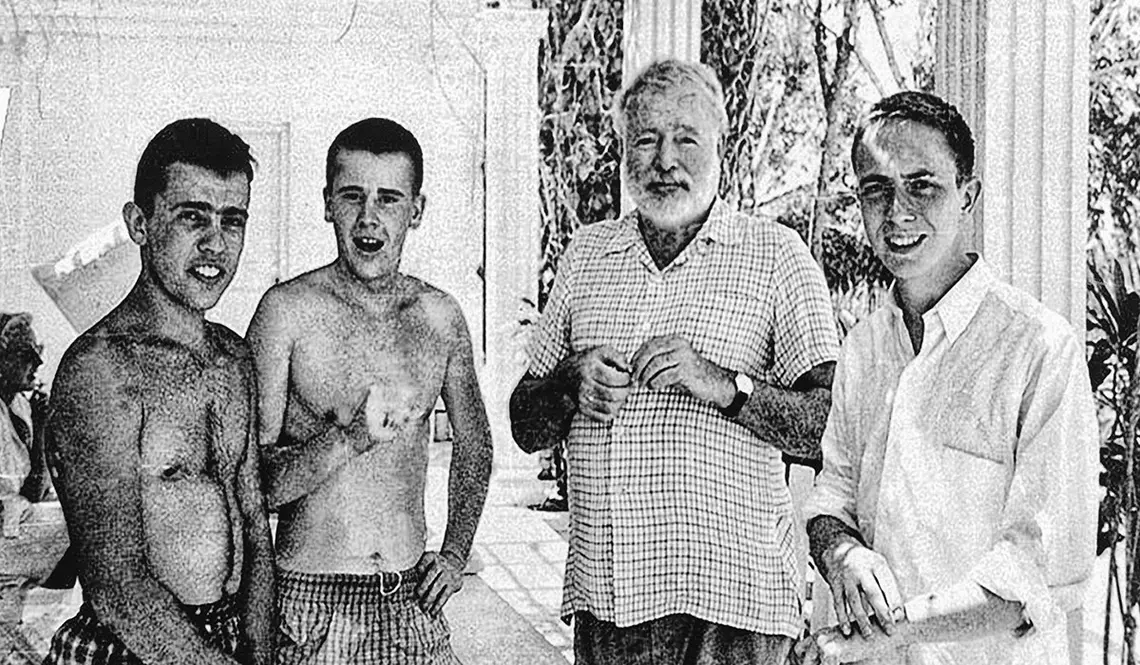
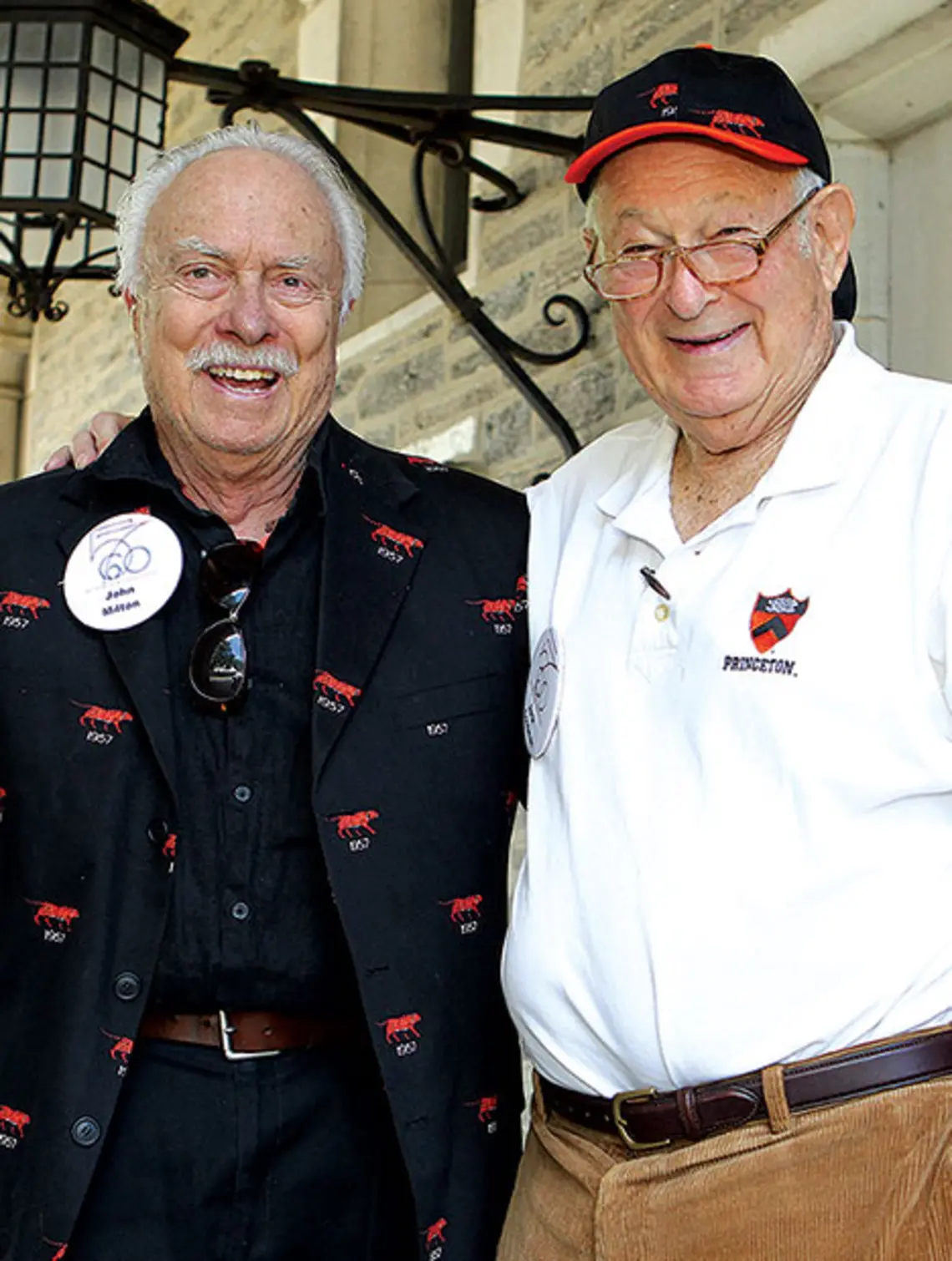
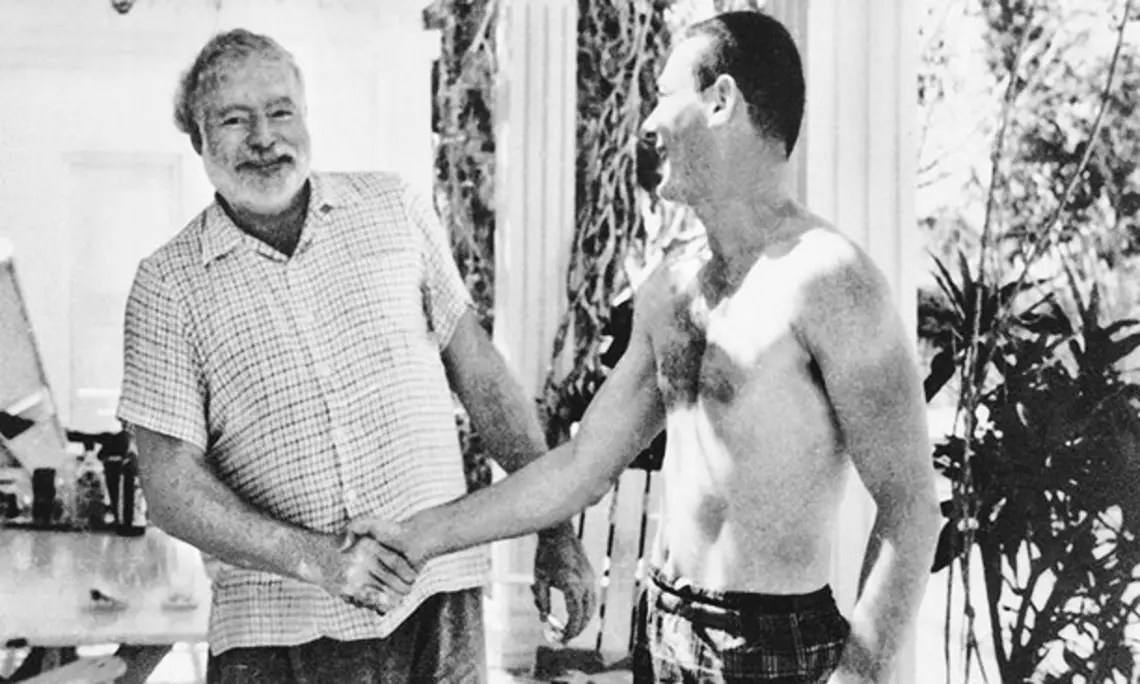
When John Milton ’57 first saw Ernest Hemingway, he was struck by the author’s size: “He was huge. ... A fairly robust body — big arms, shoulders — and the beard, which had turned gray by that time; and then the wound on the head …”
It was 1955, and Hemingway was convalescing at his home outside Havana, a year after he’d been injured in a pair of airplane crashes in Africa. Milton, Jack Goodman ’57, and two other Princeton classmates arrived at his front door with a letter of introduction from Carlos Baker *40, their English professor, who had written Hemingway: The Writer as Artist three years earlier.
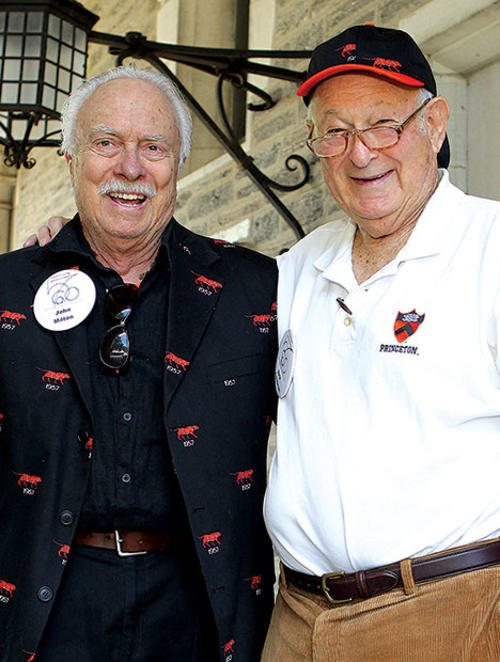
Hemingway’s wife, Mary, eventually ushered the boys out, and they retreated to a dirt-floored bar down the road to scribble notes for a pair of Daily Princetonian articles that would run the next week.
Back on campus, rumors added a fantastic dimension to the trip: One had Hemingway diving into the pool to save a drowning Bill Tangney ’57; in truth, no one went into the water. But the actual story was nearly as remarkable — and still worth retelling, 62 years later. Goodman and Milton were among 13 alumni who recorded oral-history interviews at Reunions for our PAW Tracks podcast.
PAW podcasts are also available on iTunes — click here to subscribe
TRANSCRIPT
Brett Tomlinson: Princeton professor Carlos Baker *40 was Ernest Hemingway’s official biographer; he never met the Nobel Prize-winning novelist. In 1955, though, he played a role in bringing four eager students from the Class of 1957 to Hemingway’s doorstep in Cuba on what has to rank among the most ambitious spring-break trips in history. Jack Goodman and John Milton, two of the four, recalled the story in an interview at Reunions last month. Here’s Goodman, explaining how it all began.
Jack Goodman: We were taking a modern American literature course. And it rolled around to spring vacation, and several of us — to be exact, four — Bill Tangney, Johnny Milton, myself, and Alan Graber, were sort of all working on the Prince but we didn’t have anything really to do with spring vacation, and then we learned that Ernest Hemingway spent time in Key West, and a lot of guys used to drive down to, at that time it was Fort Lauderdale.
I went to Carlos and asked him if he’d write me a letter of introduction to Hemingway because I wanted to go meet him, and I had some other Princetonians who wanted to go. And Carlos said sure. So he wrote a nice introduction and I had a letter, took it with us, went down to Key West and when we got there we were told, no, no, he’s not here, he’s in Cuba.
BT: The whole plan was a longshot, Milton says.
JM: Carlos never expected we were going to get to see him. He figured that impediments of girls on the beach in Fort Lauderdale, flying over there, getting through — and we didn’t speak any Spanish — and getting through the whole mosh to arrive there, I think he probably figured that Mary would screen us out.
BT: Mary was Hemingway’s wife, and eventually she was the one who ushered the boys away. But that’s jumping ahead. First, the students had to make their way to Cuba. The plane tickets were an unexpected expense, but they managed to pool together enough money to pay for short flight, partly by forgoing a hotel room and sleeping on the beach in Key West.
JG: So we landed in Havana that morning and hitchhiked and bused up into a town called San Francisco De Paula.
JM: There was a driveway that went from the town up to the Hemingways’ — to his house. And there was a fruit truck that was coming to deliver fruits and vegetables and we glommed onto that and hitched that one. So we got up near the front door.
JG: A servant came to the door in a white jacket. And sounding like a very official person I pulled out this letter on Princeton stationery and said I have a personal message for Ernest Hemingway. Is this his home? The response was, “Rene, who the hell is it?” — from Hemingway.
BT: Hemingway did not take kindly to morning visitors. That was his time for writing, a detail that the boys hadn’t realized. The writer also was still recovering from a pair of airplane crashes in Africa the year before. He hadn’t been healthy enough to travel to Sweden to accept the Nobel Prize for literature just four months earlier.
JG: And when we walked in he was on the right. He had a typewriter sitting on a mantelpiece because he couldn’t sit down and write. He was writing, standing up typing with this typewriter on this mantelpiece.
BT: The boys were led down to the pool to wait.
JM: Well while we were there, which was about close to five hours, sitting, beer would come. It was Cerveza Atwell, which is still sold in Cuba, they still make it down there. And then a cart came with the makings of something more serious, which was for him when he came down. And you know, I think we had quite a bit of gin, along with the beer, and then we kind of interviewed him but he just — it was more or less of a monologue.
JG: All of us had a paper due when we got back. And all of us figured, boy oh boy this is going to make writing it a lot easier.
The first question someone asked was “What do you make of Faulkner?” And I remember his reply quite clearly. It was, “Well, when he’s good, he’s very, very good.” Dead silence. Leaving it up to us to finish the statement.
JM: He was huge. For me, I was still growing, and I saw this giant man. You know, a fairly robust body. Big arms, shoulders, and the beard, which had turned gray by that time, and then the wound on the head, which turned out to be one of several that he got, knocks on the head, that he got over the years.
JG: It squared what I expected to see. Nothing surprised me except one thing: He had a very high-pitched voice that you didn’t expect to go with this huge, robust body.
JM: Barrel chested.
JG: And there are very few recordings of him. If you ever have a chance to listen to them, they’re very thin and tinny.
JM: That’s good, I never remembered — yeah, but he’s right.
BT: You can get some sense of Hemingway’s voice from the final lines of the speech that he’d prepared for the Nobel Prize banquet.
Ernest Hemingway: I have spoken too long for a writer. A writer should write what he has to say and not speak it.
JG: But the more interesting thing was that he wasn’t at all disinterested in talking about literature. Carlos was trying to explain to us about symbolism and literature at this point, and he had used a number of Hemingway examples. So I just blurted out, “Do you put a lot of deliberate symbols in your novels?” And he says, “Symbols, symbols. Oh, symbols are everyplace,” he said. “They just sort of naturally occur,” he said. He picked up a carrot, which was shaped like a phallus and says, “This is a great symbol,” and waved it at us. And it went on from there. Do you remember some of the other things?
JM: I do remember one thing and it’s, one of us was still conscious enough to be able to ask about writing and do you have any advice for us as young, aspiring writers, and what I remembered and it’s ingrained in my brain. He said, “If you’re a writer, you write. When you wake up in the morning, no matter how much you had to drink the night before, no matter whose bed you climbed out of, you write. If you don’t, you’re not a writer.”
BT: Before our interview, Goodman conferred with Alan Graber ’57, who wrote his recollections of the trip.
JG: It’s amazing how close we are on most things, but on some things we did differ completely. He has us frolicking in the pool—
JM: And we didn’t.
JG: But there was a story about the fourth one—
JM: Tangney.
JG: Bill Tangney ’57, falling into the pool and Hemingway diving in and saving his life, and that went around the campus like wildfire and that was not true either, as far as I can remember.
BT: Hemingway did give the boys some relationship advice.
JG: As we were drinking [Hemingway] said this stuff is great stuff, he said, “Have some more but just one piece of advice: Never write your girlfriend at night or when you’re drunk.” And that turned out to be good advice to follow, all the way up to our 60th reunion.
JM: Which we may or may not have followed.
JG: When he was in the room, you knew it. He owned it, and this was a guy who just had a presence like nobody I’ve ever met before, or probably since.
BT: The visit was memorable, but relatively brief. Mary Hemingway sent the boys back to town when it was time for the afternoon meal to be served.
JG: What we did after that was we went down this dusty road, down to the bar with the chicken scratching in the dirt and said we’ve got to write notes, we’ve to write our notes, because we didn’t take any notes while we were talking. But we were all pretty blind drunk, too, at the same time, so everybody was writing notes, nobody could read his notes when we got sober.
JM: At the Prince office, which was over on University Place, we had to put these, all these notes together, and try and figure, make a story out of it, which we did, you know, which turned out to be pretty cogent, readable.
BT: The first ran April 12, 1955, with a picture on the front page; a follow-up, focused on Hemingway’s comments about writing and literature, was published two days later.
JM: Before people had iPhones people actually read things like the Prince and The New York Times. And so this comes out, this is front page, Daily Princetonian, so everybody on campus read the thing, you know. And—
JG: That John Milton, who was just a face in the crowd, suddenly became somebody people would point to.
JM: Well, yeah. We really did become well known about that, and people would ask us questions and I think we probably — the stories we spun from there were probably exaggerated.
BT: But the story is still worth telling, 62 years later, and Goodman is thankful for the place, and the person, who made it possible.
JG: It’s universities like Princeton, that have professors like Carlos Baker, that serendipitously make something like this possible for venturesome, or at least eager, young writers and reporters.
BT: A coda, from Hemingway himself. In Baker’s 1969 biography of Hemingway, the author’s notes mention a letter he received from Hemingway in May 1955. In it, Hemingway gave the professor a “mild upbraiding” for sending his students to visit. But he went on to say, “I didn’t mind seeing those kids at all. They were cheerful and pleasant. I wish it had been possible to have told them a convenient time to have seen them.”
Our thanks to Jack Goodman and John Milton for sharing their story. Brett Tomlinson produced this episode. The music is licensed from FirstCom Music.
Paw in print
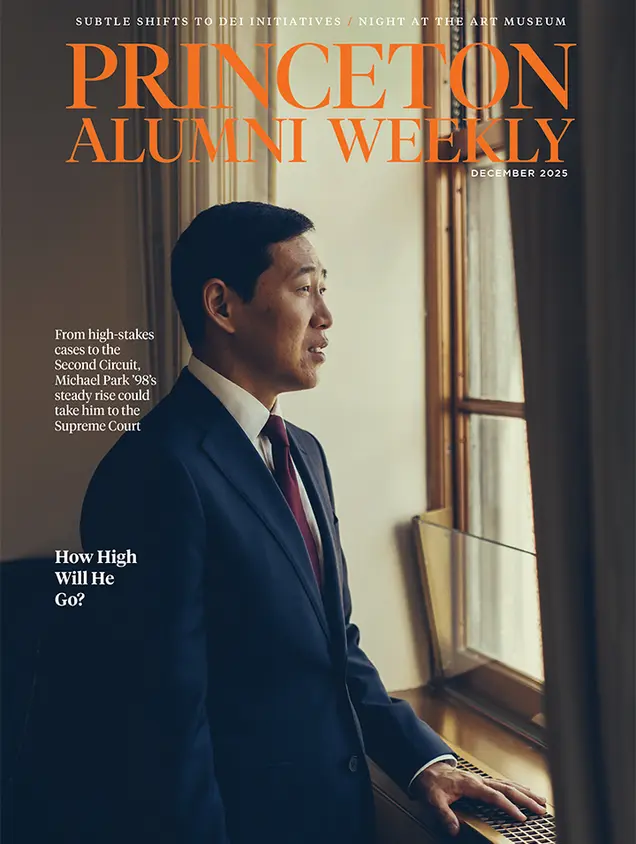
December 2025
Judge Michael Park ’98; shifts in DEI initiatives; a night at the new art museum.

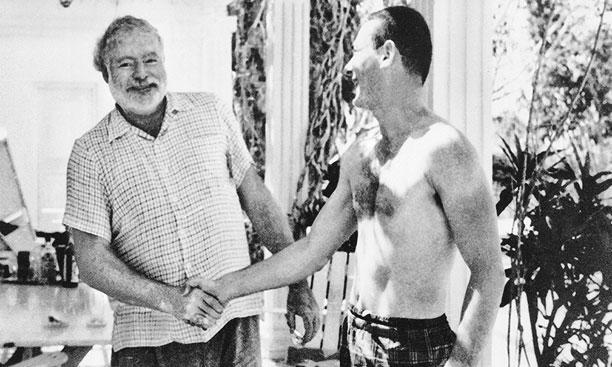
1 Response
Randal Marlin ’59
8 Years AgoAs a cub "Prince" reporter...
Very interesting. As a cub "Prince" reporter around 1956 I heard the name Bill Tangney spoken of with admiration and in legendary terms. It's good to hear some of the factual details. I later took a course from Carlos Baker and enjoyed it very much. I had the impression that the Baker-Hemingway relation was much closer, and am surprised to learn that they never met. I was in Pamplona a few years ago during the San Fermin running of the bulls. The name Hemingway is well known there. I thought a lot about Baker and Hemingway. The air of danger will no doubt have been heightened since last year's death by goring. I'm writing this during San Fermin week, but am safely in Ottawa. My agility was never great, but currently the odds of my outrunning even the lamest bull are pretty slim. I have a funny story they tell in Pamplona about bull-fighting, but it's not printable.